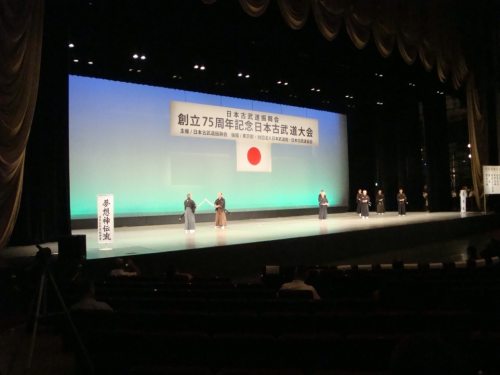The following article is part of an interview with Kajitsuka Sensei, who is the Secretary General of the Nihon Kobudo Shinkokai (the Society for the Promotion of Japanese Classical Martial Arts and Ways) (日本古武道振興会 ), the oldest national association of the classical styles of Japanese budo and bujutsu (koryu) in Japan.
In this third and final part, Kajitsuka Sensei discusses about the purposes, goals, and theory of budo associations in general.
Those interested in learning more about Kajitsuka Sensei can consult his group’s website: http://www.arakido.org/
Part Three: About Associations in General (in Theory)
Question: In your opinion, what is the purpose of (budo) associations?
Sensei: Yes, that’s an interesting question. I cannot speak for all associations in general but as regards our kobudo association, I believe we have an important purpose. Kobudo is not purely about fighting and combat only. Yes, the arts that our members practice are combat arts and so naturally there is a focus on combat, on fighting. But Kobudo also includes the wisdom of how to live; how to live as a person, as a human being. If we think in terms of a single style, this is ultimately what the founder of that specific style learned under the risk of his life on a battlefield. Therefore I think that Kobudo is a precious property of not only Japan but also of all human beings, no matter what nationality they are.
I think that this is one of the missions of our association: to have the people of the world know about it. At the same time, we want to have many Japanese people know about these Kobudo too. I think generally speaking, that this is the purpose of any association in general; namely, to have people know and understand about their particular interest.
Question: What do you think are the benefits of association? (e.g., pooling resources)
Sensei: We, as in the association, can offer a place where each ryuha can exchange skills, opinions, and so on with each other. In addition, we can become united in our efforts and can present one common interest to appeal to the world. I think that it is one of the benefits of association.
Question: What do you see as the dangers (or pitfalls) of associations? (e.g., divisive politics, cliques)
Sensei: There is a possibility that some politicians use an association for other purposes.
There is a possibility that one person with a specific thought* could rule over an association.
In such a case, the association’s activities would be guided by the political agenda of that leader.
(* a person with an agenda)
Question: How do you think associations fall apart or disintegrate? What do you think are some common causes?
Sensei: In the case of kobudo, each ryuha has been protecting its own unique tradition and interests for several hundred years. Therefore, it is not unreasonable that they are very self-respecting. In other words, they are proud of what they do and who they are. It is natural to feel this way. However, the danger is that it is easy to become exclusive. By this, I mean that there is the possibility that they do not recognize other ryuha.* There is also the danger that they will slander each other. If this happens, the association will not be unified. Of course, this would be the worst case scenario.
(* There is the possibility that schools become so insular, paying attention only to what they do, that they become overly proud of themselves and recognize no one else. And as a consequence, they will eventually come to slander other groups.)
Question: What do you think is necessary for an association to succeed and to grow?
Sensei: First of all, it is important to deepen the exchange between schools. Each ryuha is founded under the influence of other ryuha. What I mean is that each ryuha does not come into being in a vacuum. They are influenced by, and also in their turn influence other ryuha. They are all inter-connected with each other in many ways.
You can understand your ryuha in a deep way by studying not only your own ryuha, but also other ryuha as well. But this is only possible through the interchange and exchange between the various ryuha.
In addition, through the interchange between the ryuha, I hope that all kobudo practitioners will come to see that all martial arts have a common root and in the end, they all have the same purpose. If we can achieve this kind of understanding, we can become more united and ultimately, we will be able to achieve greater things. This is what I think.
Question: As Secretary General, what do you want to achieve in your term in office?
Sensei: The activity of the association is mainly to hold enbukai now. In our current situation, we don't have the means to appeal to a wider audience besides our enbukai. So, first, I would like to establish the means for doing so. By this, I mean that we need to keep current with what is happening in the world. Since a lot of information is now exchanged electronically, we need to create a website for our association so that we can provide information about ourselves to the world.
Question: Thank you Sensei for this interview. It truly was a great honour for us to talk with you about your association.
Sensei: You are very welcome.
Mr. David Kawazu-Barber and Kajitsuka Sensei demonstrating Yagyu Shingan Ryu
Announcement
A Special 2-Day Intensive Seminar In
Yagyu Shinkage Ryu Kenjutsu
July 15 & 16, 2012
With
Yasushi Kajitsuka Sensei
from Tochigi, Japan
Don’t miss this once-in-a-lifetime chance to spend some quality time with one of the great masters of Japanese classical martial arts. Attendance is limited to 20 people. For more information, visit: www.tokumeikan.org
Mr. Tong can be contacted via email at: doug@dragonfencing.com

